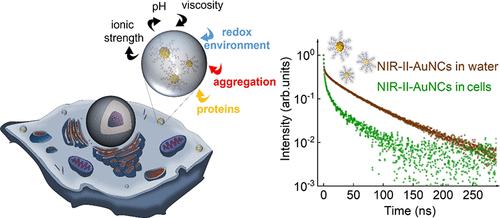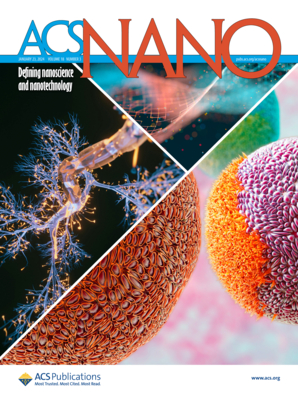Luminescence Fingerprint of Intracellular NIR-II Gold Nanocluster Transformation: Implications for Sensing and Imaging
IF 15.8
1区 材料科学
Q1 CHEMISTRY, MULTIDISCIPLINARY
引用次数: 0
Abstract
Gold nanoclusters emitting in the second biological window (NIR-II-AuNCs) have gained significant interest for their potential in deep-tissue bioimaging and biosensing applications due to the partial transparency and reduced autofluorescence of tissues in this spectral range. However, the limited understanding of how the biological environment affects their luminescent properties might hinder their use in bioimaging and biosensing. In this study, we investigated the emission properties of NIR-II-AuNCs when interacting and internalizing into live cells including macrophages, fibroblasts, and cancer cell lines, revealing substantial alterations in their luminescence. A systematic comparison between control and in vitro experiments concluded that the disruption of surface ligands is the main factor responsible for these alterations. NIR-II-AuNCs within cellular environments may also be influenced by other interactions, including aggregation or complexation with proteins. Furthermore, we also corroborated these spectroscopic modifications at the in vivo level, providing additional evidence of the environmental sensitivity of NIR-II-AuNCs. The results obtained in this study contribute to a deeper understanding of the luminescence mechanisms of NIR-II-AuNCs in biological environments in cells and in living tissues and are crucial for their optimization as reliable tools in biological environment for in vitro and in vivo imaging and diagnostics.

求助全文
约1分钟内获得全文
求助全文
来源期刊

ACS Nano
工程技术-材料科学:综合
CiteScore
26.00
自引率
4.10%
发文量
1627
审稿时长
1.7 months
期刊介绍:
ACS Nano, published monthly, serves as an international forum for comprehensive articles on nanoscience and nanotechnology research at the intersections of chemistry, biology, materials science, physics, and engineering. The journal fosters communication among scientists in these communities, facilitating collaboration, new research opportunities, and advancements through discoveries. ACS Nano covers synthesis, assembly, characterization, theory, and simulation of nanostructures, nanobiotechnology, nanofabrication, methods and tools for nanoscience and nanotechnology, and self- and directed-assembly. Alongside original research articles, it offers thorough reviews, perspectives on cutting-edge research, and discussions envisioning the future of nanoscience and nanotechnology.
 求助内容:
求助内容: 应助结果提醒方式:
应助结果提醒方式:


